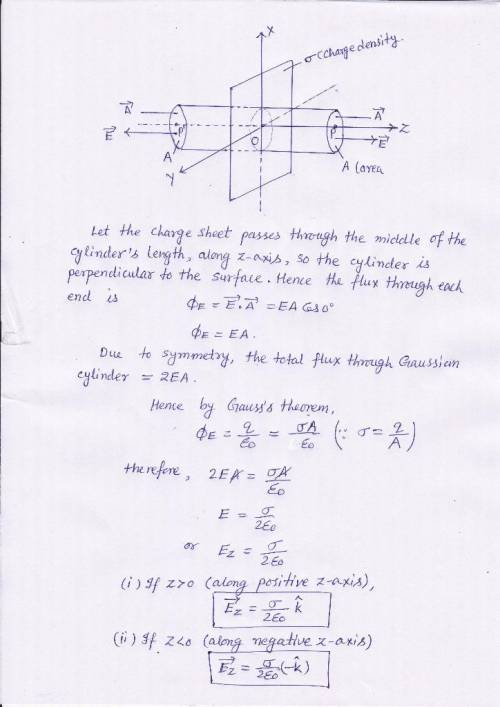
Physics, 06.05.2020 04:21 JuanTorres7
In solving for the magnitude of the electric field E⃗(z) produced by a sheet charge with charge density σ, use the planar symmetry since the charge distribution doesn't change if you slide it in any direction of xy plane parallel to the sheet. Therefore at each point, the electric field is perpendicular to the sheet and must have the same magnitude at any given distance on either side of the sheet. To take advantage of these symmetry properties, use a Gaussian surface in the shape of a cylinder with its axis perpendicular to the sheet of charge, with ends of area A which will cancel out of the expression for E(z) in the end. The result of applying Gauss's law to this situation then gives an expression for E(z) for both z>0 and z<0. (Figure 3) Express E(z) for z>0 in terms of some or all of the variables/constants σ, z, and ϵ0.

Answers: 3


Another question on Physics

Physics, 22.06.2019 08:30
Individuals who live below the poverty line get seriously ill more often than those who do not what could be the hidden variable in this situation?
Answers: 3

Physics, 22.06.2019 14:00
An object resting on a table weighs 100 n. with what force is the object pushing on the table? with what force is the table pushing on the object? explain how you got your answer.
Answers: 1

Physics, 22.06.2019 18:00
Cells in the nervous system have a potential difference of 70 mv across the cell membrane separating the interior of the cell from the extracellular fluid. this potential difference is maintained by ion pumps that move charged ions across the membrane. is this an emf? select the correct answer and explanation. 1)no. the ion pumps cannot separate charges; thus, they cannot create a potential difference. 2)yes. the ion pumps cannot separate charges, but they still can create a potential difference. 3)yes. the ion pumps can actively separate charge; thus, they can create a potential difference. 4)no. the ion pumps can separate charges, but they cannot create a potential difference.
Answers: 1

Physics, 22.06.2019 19:30
Visualize the problem and identify special cases first examine the problem by drawing a picture and visualizing the motion. apply newton's 2nd law, ∑f⃗ =ma⃗ , to each body in your mind. don't worry about which quantities are given. think about the forces on each body: how are these consistent with the direction of the acceleration for that body? can you think of any special cases that you can solve quickly now and use to test your understanding later? one special case in this problem is if m2=0, in which case block 1 would simply fall freely under the acceleration of gravity: a⃗ 1=−gj^.
Answers: 1
You know the right answer?
In solving for the magnitude of the electric field E⃗(z) produced by a sheet charge with charge dens...
Questions

German, 10.12.2020 01:50

Mathematics, 10.12.2020 01:50



Mathematics, 10.12.2020 01:50

English, 10.12.2020 01:50



History, 10.12.2020 01:50



English, 10.12.2020 01:50

English, 10.12.2020 01:50


Mathematics, 10.12.2020 01:50

Mathematics, 10.12.2020 01:50

Spanish, 10.12.2020 01:50

History, 10.12.2020 01:50





